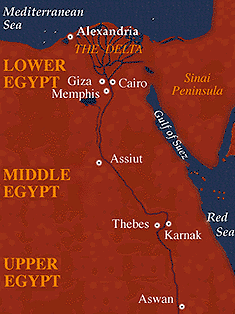The Nile Valley civilization, also known as the Nile Valley culture or the ancient Egyptian civilization, was a civilization that flourished along the banks of the Nile River in northeastern Africa for over three thousand years. It is considered one of the oldest and most enduring civilizations in the world.
The civilization developed in the Nile Valley around 3000 BCE, and its history can be divided into three main periods: the Old Kingdom (2700-2200 BCE), the Middle Kingdom (2000-1700 BCE) and the New Kingdom (1550-1070 BCE). Each of these periods saw significant developments in art, architecture, religion, and governance.
One of the key features of the Nile Valley civilization was its reliance on the Nile River for its survival. The Nile provided a reliable source of water for irrigation, transportation, and fishing, and its annual floods deposited fertile silt on the banks of the river, enabling the growth of crops such as wheat, barley, and flax. This agricultural abundance supported the growth of cities and the development of trade, which played a significant role in the economic and cultural flourishing of the civilization.
Another important aspect of the Nile Valley civilization was its strong cultural and religious traditions. The ancient Egyptians believed in a complex pantheon of gods and goddesses, and their religion played a central role in their daily lives. Temples, tombs, and other religious structures were some of the most impressive and enduring buildings of the civilization, and the study of hieroglyphics, the written language of the ancient Egyptians, has helped historians to understand their beliefs and practices.
Art and architecture were also integral parts of the Nile Valley civilization. The ancient Egyptians are renowned for their elaborate tombs and pyramids, which were built to house the remains of the Pharaohs and their families. These structures were decorated with intricate carvings, paintings, and sculptures that depicted the lives and beliefs of the ancient Egyptians. In addition, the ancient Egyptians were skilled craftsmen who produced a wide range of artifacts, including jewelry, pottery, and furniture.
In conclusion, the Nile Valley civilization was a complex and enduring civilization that flourished along the banks of the Nile River for over three thousand years. Its reliance on the Nile, its strong cultural and religious traditions, and its impressive art and architecture are all key features that have contributed to its lasting legacy.
Nile Valley Civilizations (9780887386220) by @ webapi.bu.edu

This was the time which was marked by Neolithic Revolution Williams, p. EGYPT TOURS AND TRIPS Ancient wonders. They show the Nile Valley civilizations to be a source of science and philosophy, as part of the Judeo-Chris-tian heritage, and as influences on ancient America and Asia, shedding new light on neglected realities of history. Not only the king but also the female who accompanied the king, usually the queen, was revered with equal respect. It began in the lower Nile Valley, in what is today Sudan, and flourished between c.
The Ancient Nile Valley: Civilizations, Region & Facts

Q-Why is the Nile River important? The deification of other animals and concepts is demonstrated with the the first known megalith, Horemakhet often misnamed the "Great Sphinx" , constructed further down the Nile 7000-5000 BC. A- The most important thing the Nile provided to the Ancient Egyptians was fertile land. Some of the soonest known civilizations origi. Nabta Playa Calendar, courtesy of Raymbetz Horemakhet the Great Sphinx , courtesy of Nina Aldin Thune Cultural developments can be traced north of the confluence of the White and Blue Nile in modern-day Sudan. In contrast, the hot, dry desert areas were Deshret, the "red land. Q- How long is a Nile Cruise? WATCH: The Nile Was a Source of Rich Farmland The Nile's modern name comes from the Nelios, the Greek word for river valley.
Nile Valley civilizations : proceedings of the Nile Valley Conference, Atlanta, Sept. 26

Please review the book on Amazon and send us your e-mail if you wanted the full text of the "Manual;" we will send you the free electronic copy. A-The Nile River is approximately 4,100 miles long and was historically thought to be the longest river in the world. Ancient Nile River Valley Although the Nile's water flow is now controlled by the Aswan Dam, constructed first in 1902 and added to in the 1960s and 1970s, the river's seasonal flooding was extremely important to ancient Egyptian civilization. The so-called Ishango bone's inscriptions consist of two columns of odd numbers that add up to 60, with the left column containing prime numbers between 10 and 20, and the right column containing both added and subtracted numbers. However, its legacy has lasted for millennia, and it continues to be studied by archaeologists and historians today. It creates an interesting mix of old and new that can only be found in Luxor. This gave rise to a maritime culture in the Lower Nile, in which large ships were perhaps used as early as 7000 BC to help facilitate the exchange of culture, knowledge, goods, and services.







